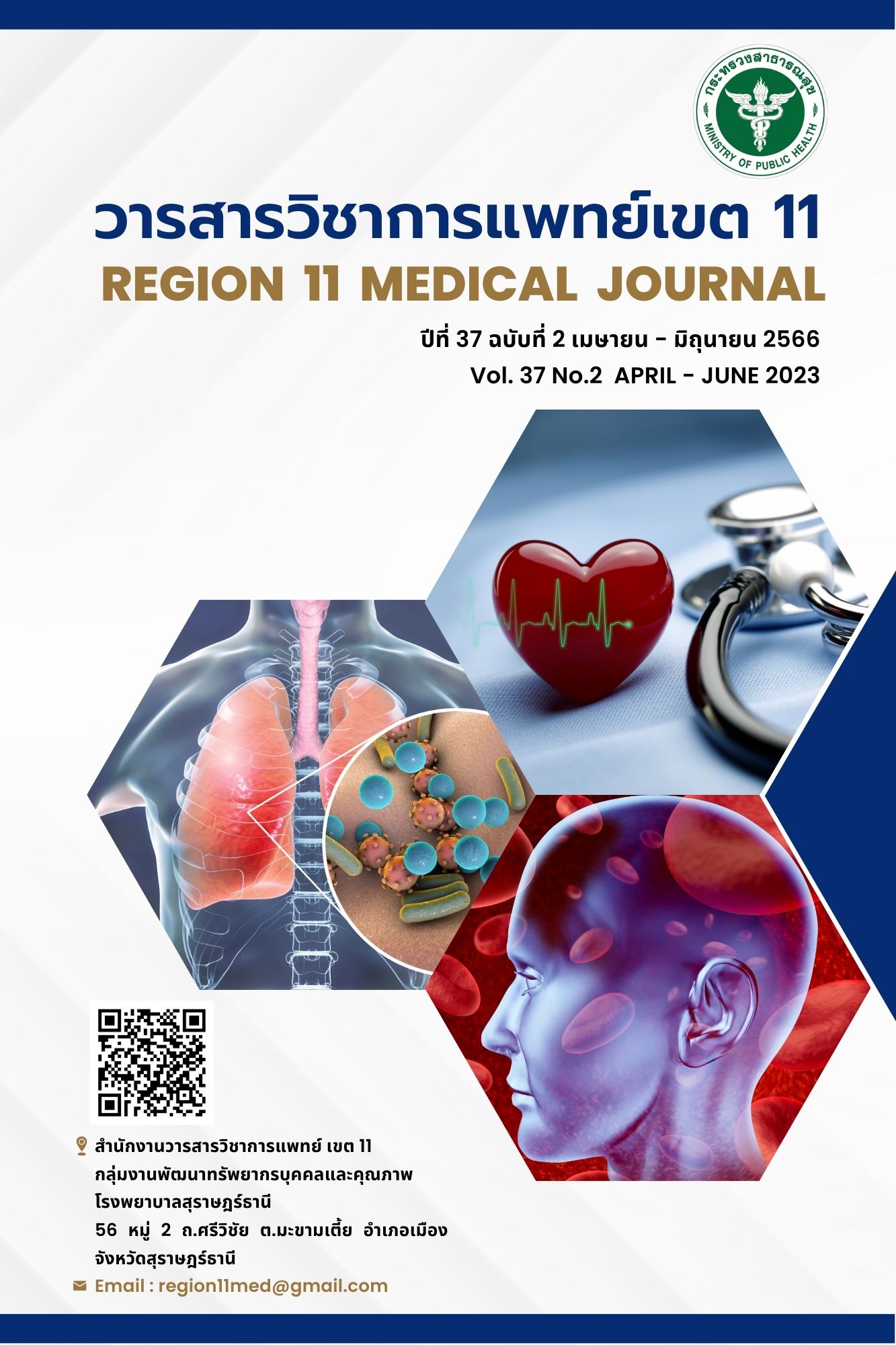A Pre-post Study on Hemodynamic Differences Following Percutaneous Mitral Commissurotomy in Mitral Stenosis Patients with Atrial Fibrillation and Sinus Rhythm
Keywords:
Atrial Fibrillation, Hemodynamic, Percutaneous Mitral Commissurotomy, Sinus RhythmAbstract
Background: The development of atrial fibrillation (AF) is a common condition in mitral stenosis (MS), and the monitoring of hemodynamic parameters in patients after a successful percutaneous mitral commissurotomy (PMC) is of great importance for the prediction of late events. Objective: This study aimed to investigate the pre-and post-PMC hemodynamic data between AF and sinus rhythm (SR) patients.
Methods: This was a retrospective study consisting of 98 patients who underwent PMC at Suratthani Hospital between January 2013 and December 2019. Patient characteristics, echocardiogram, and hemodynamic data before and after PMC were collected, and a student t-test was applied to compare the differences between AF and SR groups.
Results: Of 98 patients, the majority of patients were in the AF category (75.5%). The age of the patients with AF was significantly higher than SR in the study (54.66±11.80 vs 48.79±13.26 years; p=0.04). Pre-PMC hemodynamic data showed that the AF group had significantly larger LA size (5.49±0.80 vs 4.95±0.63 cm; p<0.01) and higher LA pressure (25.56±8.26 vs 20.0±8.52 mmHg; p<0.01) than the SR group. After PMC, LA size was also significantly higher in the patients with AF than SR (5.16±0.73 vs 4.54±0.81 cm; p<0.01). Post-PMC LAP between the groups had a similar trend (18.76±7.17 vs 12.91±5.43 mmHg; p<0.01). However, the pre-and post-PMC readings for MVA, mean pulmonary pressure and transmitral pressure gradients were statistically not different between AF and SR groups.
Conclusion: The patients with MS and AF were older and they had considerably larger LA size and higher LA pressure than patients with MS and SR. The SR group had lower but insignificantly different pulmonary artery systolic pressure than the AF group in the study.
References
Verdino RJ. Untreated atrial fibrillation in the United States of America: Understanding the barriers and treatment options. J Saudi Heart Assoc. 2015;27(1):44-9.
Kanji I, Takane O, Takasumi N, Fumio K, Nobuaki M. Clinical application of transvenous mitral commissurotomy by a new balloon catheter. The Journal of Thoracic and Cardiovascular Surgery. 1984;87(3):394-402.
Braiteh N, Zgheib A, Kashou AH, Dimassi H, Ghanem G. Immediate and long-term results of percutaneous mitral commissurotomy: up to 15 years. Am J Cardiovasc Dis. 2019;9(4):34-41.
Miura S, Arita T, Domei T, Yamaji K, Soga Y, Hyodo M, et al. Impact of preprocedural atrial fibrillation on immediate and long-term outcomes after successful percutaneous mitral valvuloplasty of significant mitral stenosis. Cardiovasc Interv Ther. 2018;33(1):46-54.
Iung B, Leenhardt A, Extramiana F. Management of atrial fibrillation in patients with rheumatic mitral stenosis. Heart. 2018;104(13):1062-8.
Sharma SK, Verma SH. A Clinical Evaluation of Atrial Fibrillation in Rheumatic Heart Disease. J Assoc Physicians India. 2015;63(6):22-5.
Kirchhof P, Benussi S, Kotecha D, Ahlsson A, Atar D, Casadei B, et al. 2016 ESC Guidelines for the management of atrial fibrillation developed in collaboration with EACTS. Eur Heart J. 2016;37(38):2893-962.
Staerk L, Sherer JA, Ko D, Benjamin EJ, Helm RH. Atrial Fibrillation: Epidemiology, Pathophysiology, and Clinical Outcomes. Circ Res. 2017;120(9):1501-17.
Woroszylska M, Ruzyllo W, Konka M, Soroka M, Dabrowski M, Chmielak Z, et al. Long term follow up after percutaneous mitral commissurotomy with the Inoue balloon-incidence of restenosis. J Heart Valve Dis. 1994;3(6):594-601.
Morseth B, Geelhoed B, Linneberg A, Johansson L, Kuulasmaa K, Salomaa V, et al. Age-specific atrial fibrillation incidence, attributable risk factors and risk of stroke and mortality: results from the MORGAM Consortium. Open Heart. 2021;8(2).
Zoni-Berisso M, Lercari F, Carazza T, Domenicucci S. Epidemiology of atrial fibrillation: European perspective. Clin Epidemiol. 2014;6:213-20.
Wood AD, Mannu GS, Clark AB, Tiamkao S, Kongbunkiat K, Bettencourt-Silva JH, et al. Rheumatic Mitral Valve Disease Is Associated With Worse Outcomes in Stroke: A Thailand National Database Study. Stroke. 2016;47(11):2695-701.
Sankaranarayanan R, Kirkwood G, Dibb K, Garratt CJ. Comparison of Atrial Fibrillation in the Young versus That in the Elderly: A Review. Cardiol Res Pract. 2013;2013:976976.
Ohlmeier C, Mikolajczyk R, Haverkamp W, Garbe E. Incidence, prevalence, and antithrombotic management of atrial fibrillation in elderly Germans. Europace. 2013;15(10):1436-44.
Schnabel RB, Yin X, Gona P, Larson MG, Beiser AS, McManus DD, et al. 50 year trends in atrial fibrillation prevalence, incidence, risk factors, and mortality in the Framingham Heart Study: a cohort study. Lancet. 2015;386(9989):154-62.
Jayaram AA, Shukla AN, Shah S, Nayak V, Prabhu S, Pai U. Sinus Rhythm in Rheumatic Mitral Stenosis after Balloon Mitral Valvotomy: Is it Feasible? J Clin Diagn Res. 2017;11(2):OC01-OC5.
Yoshida K, Ulfarsson M, Oral H, Crawford T, Good E, Jongnarangsin K, et al. Left atrial pressure and dominant frequency of atrial fibrillation in humans. Heart Rhythm. 2011;8(2):181-7.
Srimahachota S, Boonyaratavej S, Wannakrairoj M, Udayachalerm W, Sangwattanaroj S, Ngarmukos P, et al. Percutaneous transvenous mitral commissurotomy: hemodynamic and initial outcome differences between atrial fibrillation and sinus rhythm in rheumatic mitral stenosis patients. J Med Assoc Thai. 2001;84(5):674-80.
Nachom P, Ratanasit N. Incidence and Predictors of Long-Term Adverse Outcomes in Patients with Rheumatic Mitral Stenosis in Sinus Rhythm. J Med Assoc Thai. 2016;99(4):374-80.
Chichareon P, Nilmoje T, Suwanugsorn S, Chamnarnphol N, Thungthienthong M, Geater SL, et al. Procedural success and outcomes after percutaneous balloon mitral valvuloplasty in rheumatic mitral stenosis with moderate mitral regurgitation: a retrospective cohort study. Cardiovasc Diagn Ther. 2022;12(5):552-62.
Downloads
Published
How to Cite
Issue
Section
License
Copyright (c) 2023 Region11Medical Journal

This work is licensed under a Creative Commons Attribution-NonCommercial-NoDerivatives 4.0 International License.






